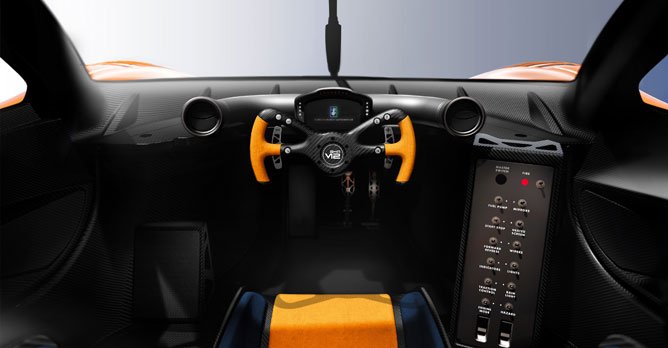Gordon Murray Automotive reveals the track-only T.50s Niki Lauda
12 Apr 2021|1,241 views
Gordon Murray Automotive has unveiled its T.50s Niki Lauda. Developed in parallel with the T.50, the T.50s Niki Lauda has been conceived, designed and engineered to offer the ultimate on-track driving experience, and the car bears the name of Niki Lauda, the legendary three-time Formula One World Champion.
Like the T.50, the T.50s Niki Lauda has been designed and engineered without compromise, but with an even more extreme specification. It weighs just 852kg and will be powered by a substantially redesigned version of the T.50's Cosworth-engineered 3.9-litre V12, producing 715bhp, revving to 12,100rpm and going through a six-speed gearbox.

Gordon Murray Automotive engineered the T.50s body design to achieve their aerodynamic performance targets, whilst retaining the T.50's balanced and classic proportions. A striking central fin designed to enhance stability features a Niki Lauda logo. At the rear, the distinctive 400mm fan from the T.50 is retained, accompanied by an even larger rear diffuser and a new delta wing.
The aerodynamic elements continue at the front of the car. Barge boards are sculpted to improve airflow to the side ducts, which house the oil cooling systems for the engine and transmission. A splitter and dive planes are also prominent and further reflect the car's aero-influenced design. Owners will be able to individualise their T.50s Niki Lauda through their choice of colours and liveries, so that no two cars will be alike.
The Cosworth-designed 3.9-litre V12 engine is a dramatically different version of the engine that powers the T.50. It is even more powerful and faster-revving too, delivering 715bhp at 11,500rpm, on its way to a 12,100rpm rev-limit. The torque figure is 485Nm at 9,000rpm.

Through meticulous attention to detail, this new iteration of the Cosworth GMA V12 weighs just 162kg, 16kg less than what was already the lightest road-going V12 engine ever. The weight-saving measures extend to the intake, exhaust and control systems, as well as the engine itself. All the valves are made from titanium, while there is no variable valve timing due to the additional weight of the geartrain and electronic control system.
A simpler induction system features 12 throttle bodies on top of the engine, fed directly by the racing-style air box. The exhaust system does without catalytic converters, has thinner Inconel walls and, with only track noise limits to meet, benefits from smaller silencers.
A Xtrac Instantaneous Gearshift six-speed gearbox is fitted, designed to fit the exacting packaging and weight demands of the T.50s Niki Lauda. As part of Xtrac's efforts to minimise weight wherever possible, even the gears are lighter, contributing to a 5kg total weight reduction. Both the gearbox and the clutch are electronically actuated.

The T.50s Niki Lauda is built around a specially developed, lightweight carbon fibre monocoque. Optimised for weight reduction and structural rigidity, it is constructed using advanced part-binding technology, with carbon fibre wrapped around a honeycomb aluminium core. This stiffness and strength also contributes to the T.50s' exceptional occupant safety, with precisely engineered deformable areas.
Exterior body panels are also made from carbon fibre. The T.50s Niki Lauda utilises the same forged aluminium front and rear double wishbone suspension system as the T.50. However, the springs, dampers and anti-roll bar have been respecified to optimise track performance, while the ride height has been lowered to 87mm at the front and 116mm at the rear.
As part of the Trackspeed package, the T.50s Niki Lauda's chassis can be adjusted to find the ideal setup for its owner. Both the chassis settings and the aerodynamics are fully adjustable. The T.50s Niki Lauda retains the T.50's rack and pinion steering, but with a revised steering ratio.

The T.50s sits on extremely light magnesium forged 18-inch wheels, weighing less than 6kg each, with centre locking hubs. Michelin slick tyres wrap around the rims, with 250mm wide tyres in front and 300m wide tyres in the rear. A wet option tyre is also provided.
The T.50s Niki Lauda has new aero creating 1,500kg of downforce, including a 1,758mm-wide, rear-mounted delta wing. The front splitter with a central aerofoil section generates huge load figures to balance out the rear wing. The splitter's central channel reduces the car's sensitivity to pitch while allowing airflow under the car to continue to drive the central diffuser section, keeping the efficiency of the entire aero package high.
Dive planes include horizontal elements paired with a vertical duct to manage wheel arch pressures and tyre wake, reducing drag and improving efficiency. A pair of NACA ducts have been perfectly positioned on the front clam shell in a region of high pressure and where the thin boundary layer is ideal for cooling the large front brakes.

To further improve airflow and accommodate the central fin, the oil cooling systems for the engine and transmission are now located in side ducts. With the powertrain coolers located directly downstream of the front wheels, barge boards have been added to manage the turbulent wake emanating from the front wheel arches, ensuring a clean flow of air to the side ducts.
The T.50s Niki Lauda retains the same 400mm ground-effect fan as the T.50, but here it runs in a single High Downforce mode, spinning at 7000rpm. The T.50s also has much simpler ducting, with a permanently open duct running down to the redesigned rear diffuser.
The dihedral doors lift to reveal a race-car oriented cabin. The T.50s Niki Lauda retains the driver-focused central seating position of the T.50, giving the driver an unhindered view of the track ahead and allowing perfect placement. The driver sits on a full racing carbon fibre seat with fore and aft adjustment and is secured with a six-point harness.

The rectangular carbon fibre steering wheel features only the key controls that the driver needs. This includes buttons for the traction and launch control, as well as the car-to-pit/driver-to-passenger radio and to select neutral. The slim, uncluttered design is influenced by Gordon Murray's racing experience.
To avoid unnecessary distractions, the T.50s features a single digital screen. This displays essential vehicle and engine data, as well as aero info, the gearchange indicator, telemetry, lap time, tyre pressures/temperatures, g-forces and a camera video feed. The T.50s also maintains the same spaciousness, visibility and comfort as the road car, making the T.50s Niki Lauda a uniquely usable track car, despite its incredible performance.
Gordon Murray Automotive has unveiled its T.50s Niki Lauda. Developed in parallel with the T.50, the T.50s Niki Lauda has been conceived, designed and engineered to offer the ultimate on-track driving experience, and the car bears the name of Niki Lauda, the legendary three-time Formula One World Champion.
Like the T.50, the T.50s Niki Lauda has been designed and engineered without compromise, but with an even more extreme specification. It weighs just 852kg and will be powered by a substantially redesigned version of the T.50's Cosworth-engineered 3.9-litre V12, producing 715bhp, revving to 12,100rpm and going through a six-speed gearbox.

Gordon Murray Automotive engineered the T.50s body design to achieve their aerodynamic performance targets, whilst retaining the T.50's balanced and classic proportions. A striking central fin designed to enhance stability features a Niki Lauda logo. At the rear, the distinctive 400mm fan from the T.50 is retained, accompanied by an even larger rear diffuser and a new delta wing.
The aerodynamic elements continue at the front of the car. Barge boards are sculpted to improve airflow to the side ducts, which house the oil cooling systems for the engine and transmission. A splitter and dive planes are also prominent and further reflect the car's aero-influenced design. Owners will be able to individualise their T.50s Niki Lauda through their choice of colours and liveries, so that no two cars will be alike.
The Cosworth-designed 3.9-litre V12 engine is a dramatically different version of the engine that powers the T.50. It is even more powerful and faster-revving too, delivering 715bhp at 11,500rpm, on its way to a 12,100rpm rev-limit. The torque figure is 485Nm at 9,000rpm.

Through meticulous attention to detail, this new iteration of the Cosworth GMA V12 weighs just 162kg, 16kg less than what was already the lightest road-going V12 engine ever. The weight-saving measures extend to the intake, exhaust and control systems, as well as the engine itself. All the valves are made from titanium, while there is no variable valve timing due to the additional weight of the geartrain and electronic control system.
A simpler induction system features 12 throttle bodies on top of the engine, fed directly by the racing-style air box. The exhaust system does without catalytic converters, has thinner Inconel walls and, with only track noise limits to meet, benefits from smaller silencers.
A Xtrac Instantaneous Gearshift six-speed gearbox is fitted, designed to fit the exacting packaging and weight demands of the T.50s Niki Lauda. As part of Xtrac's efforts to minimise weight wherever possible, even the gears are lighter, contributing to a 5kg total weight reduction. Both the gearbox and the clutch are electronically actuated.

The T.50s Niki Lauda is built around a specially developed, lightweight carbon fibre monocoque. Optimised for weight reduction and structural rigidity, it is constructed using advanced part-binding technology, with carbon fibre wrapped around a honeycomb aluminium core. This stiffness and strength also contributes to the T.50s' exceptional occupant safety, with precisely engineered deformable areas.
Exterior body panels are also made from carbon fibre. The T.50s Niki Lauda utilises the same forged aluminium front and rear double wishbone suspension system as the T.50. However, the springs, dampers and anti-roll bar have been respecified to optimise track performance, while the ride height has been lowered to 87mm at the front and 116mm at the rear.
As part of the Trackspeed package, the T.50s Niki Lauda's chassis can be adjusted to find the ideal setup for its owner. Both the chassis settings and the aerodynamics are fully adjustable. The T.50s Niki Lauda retains the T.50's rack and pinion steering, but with a revised steering ratio.

The T.50s sits on extremely light magnesium forged 18-inch wheels, weighing less than 6kg each, with centre locking hubs. Michelin slick tyres wrap around the rims, with 250mm wide tyres in front and 300m wide tyres in the rear. A wet option tyre is also provided.
The T.50s Niki Lauda has new aero creating 1,500kg of downforce, including a 1,758mm-wide, rear-mounted delta wing. The front splitter with a central aerofoil section generates huge load figures to balance out the rear wing. The splitter's central channel reduces the car's sensitivity to pitch while allowing airflow under the car to continue to drive the central diffuser section, keeping the efficiency of the entire aero package high.
Dive planes include horizontal elements paired with a vertical duct to manage wheel arch pressures and tyre wake, reducing drag and improving efficiency. A pair of NACA ducts have been perfectly positioned on the front clam shell in a region of high pressure and where the thin boundary layer is ideal for cooling the large front brakes.

To further improve airflow and accommodate the central fin, the oil cooling systems for the engine and transmission are now located in side ducts. With the powertrain coolers located directly downstream of the front wheels, barge boards have been added to manage the turbulent wake emanating from the front wheel arches, ensuring a clean flow of air to the side ducts.
The T.50s Niki Lauda retains the same 400mm ground-effect fan as the T.50, but here it runs in a single High Downforce mode, spinning at 7000rpm. The T.50s also has much simpler ducting, with a permanently open duct running down to the redesigned rear diffuser.
The dihedral doors lift to reveal a race-car oriented cabin. The T.50s Niki Lauda retains the driver-focused central seating position of the T.50, giving the driver an unhindered view of the track ahead and allowing perfect placement. The driver sits on a full racing carbon fibre seat with fore and aft adjustment and is secured with a six-point harness.

The rectangular carbon fibre steering wheel features only the key controls that the driver needs. This includes buttons for the traction and launch control, as well as the car-to-pit/driver-to-passenger radio and to select neutral. The slim, uncluttered design is influenced by Gordon Murray's racing experience.
To avoid unnecessary distractions, the T.50s features a single digital screen. This displays essential vehicle and engine data, as well as aero info, the gearchange indicator, telemetry, lap time, tyre pressures/temperatures, g-forces and a camera video feed. The T.50s also maintains the same spaciousness, visibility and comfort as the road car, making the T.50s Niki Lauda a uniquely usable track car, despite its incredible performance.
Latest COE Prices
April 2025 | 1st BIDDING
NEXT TENDER: 23 Apr 2025
CAT A$97,724
CAT B$117,899
CAT C$68,782
CAT E$117,002
View Full Results Thank You For Your Subscription.


























